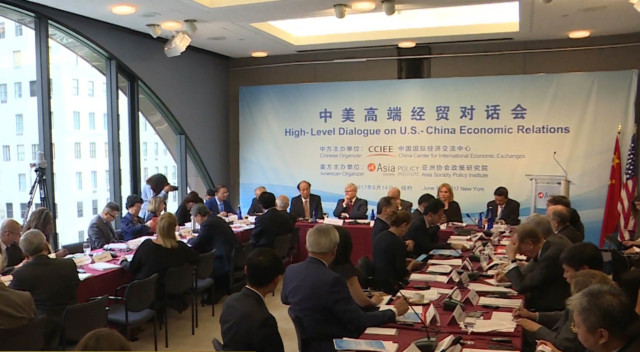New York City hosts a high-level dialogue on U.S.-China Economic Relations. It was a chance to promote China’s Belt and Road Initiative before an influential audience in Manhattan.
It was also a chance to update the 100-day economic plan set out at April’s meeting between President’s Xi and Trump in Florida.
CGTN’s John Terrett reports.
When you come up with a plan as big and bold as China’s Belt and Road Initiative you can be sure Americans will have questions about it.
At the Asia Society on Manhattan’s Upper East Side the great and the good from New York business and diplomatic community are gathering to learn more about President Xi’s modern-day Silk Road.
“We see ourselves here as professional bridge builders,” Kevin Rudd, the former Prime Minister of Australia and the current president of the Asia Society Policy Institute said.
Rudd, the keynote speaker at the event who now lives in New York, says Americans think of Belt and Road like the Marshall Plan that helped Germany recover after World War Two.
“The United States as the world’s last remaining superpower understands global complexity. And so when they look at this project they know how difficult the geopolitics are. They know how difficult the geoeconomics are. They know how difficult the local security is. They know how difficult some of the national economic cultures are,” Rudd said.
The star of the event – C.H. Tung, 79, the first Chief Executive of the Hong Kong Special Administrative Region.
His speech set out how the U.S. and China have cooperated closely in recent history – for example in the 2008 global financial crash, on climate change and in the 2016 the West Africa Ebola outbreak.
And he said the two will work closely again in the future.
“China has about twenty percent of the world population but only about seven or eight percent of arable land in the world and in the longer term China will need more and more farm products and the U.S. is a big nation producing farm products so that’s just one example.”
China’s relationship with the U.S. has never been stronger after President Xi and President Trump met in Florida last April to discuss the DPRK and to set-out a one hundred day economic plan for the two countries.
China’s ambassador to the U.S., Cui Tiankai said this is a “promising and challenging moment” and Americans should know China is not working for global dominance but mutual benefits as outlined by Presidents Xi and Trump in Florida.
“It was a successful and very productive summit. Maybe more successful than most people would expect. It set the tone and direction for our relationship to go forward,” he said.
Besides Belt and Road and the 100-day economic plan, the forum also discussed a new report designed to push back on what Beijing sees as popular myths about the trade deficit between China and the U.S.
The report also points out that 20 percent of China’s exports go to the U.S. and U.S. investment in China have grown by ten percent each year for the last ten – and 2.6 million U.S. jobs are supported by two-way investments.
After a series of private sessions, the day concluded with a news conference. The main conclusion? Belt and Road may have received a cool welcome from the U.S. administration so far, but corporate America seems keen to know more. The dialogue will be ongoing.
“Our motto here is we preference to light not heat to these discussions,” said Rudd.
Sara Hsu discusses the Belt and Road Initiative, progress in the 100 day action plan
CGTN’s Rachelle Akuffo spoke with Sara Hsu, an associate professor of Economics at the State University of New York at New Paltz about the U.S. take on the Belt & Road Initiative and progress in the bilateral 100-Day Action Plan.
 CGTN America
CGTN America

